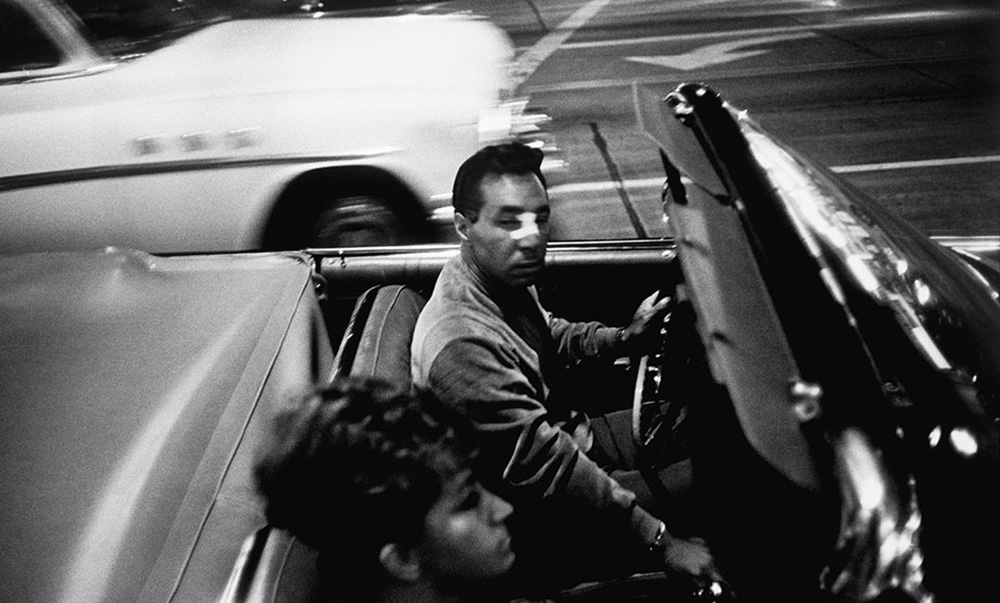You don’t realize it until well into “Garry Winogrand: All Things Are Photographable” that you rarely see the subject of the film. Of course, it makes sense since Winogrand spent his life behind the camera rather than in front of it, but still it becomes extraordinarily effective how director Sasha Waters Freyer resists taking what materials she no doubt found of the celebrated photographer to give him more physical form, instead allowing the audience to see through his eyes as one still after another floods the screen. As passed along to his friend and colleague Thomas Roma, Winogrand once remarked that photography was the “closest I get to not existing,” and in this spirited biography, you’re able to understand the tremendous impact he had because of how elusive he was capturing moments in American life that would go unnoticed otherwise.
Described at one point as the first digital photographer before the technology had been invented because of his proclivity to shoot film with abandon, Winogrand was relentless in chasing such moments, and his skill at finding the right moment is illuminated by Waters Freyers’ presentation of his work in “All Things Are Photographable,” often overlaying interviews with those who knew him and those who have been grappling with his legacy as art critics and gallery curators. This sounds simple enough, but true to the photography they’re discussing, the sophistication of what’s being done gradually emerges as photos are analyzed for their unique composition and sense of movement while personal recollections about the time they were taken in during the 1960s and ‘70s give them context. Naturally, the rise of feminism and the civil rights movement made for complex imagery, which Winogrand’s sensitivity towards – or lack thereof (he infamously published a collection entitled, “Women Are Beautiful: Observations of a Male Chauvinist Pig”) – sparks a consistently engaging debate in “All Things Are Photographable” amongst the diverse group of interviewees assembled, but perhaps even more fascinating is a sequence on his collection “The Animals,” that changes the perspective on photos that were dismissed at the time of their unveiling as being bland images from a trip to the zoo to see them through the lens of a newly divorced father spending time with his kids, which “Mad Men” creator Matthew Weiner seems to suggest was an inspiration for envisioning Don Draper’s post-Betty Draper years on the series.
While Winogrand was well aware of the many contradictions that defined his career — seeking a life as an artist when the only paid work for photography was either as a photojournalist or for ad campaigns and observing the growing trend towards staging events to create photos that could travel through the mass media rather than having them unfold naturally (which he documented in the prophetic 1977 “Public Relations,” taking pictures at such events a remove to expose their machinery) — it’s impressive how Waters Freyer makes one conscious of them as well, inviting competing perspectives on his work and slyly alluding to the prevailing cultural attitudes that shaped the photographer without his knowledge, beginning chapters with prose from John Updike and Norman Mailer and judicious musical choices or placement of interviews. The inherent kineticism of Winogrand’s photography lends itself to a dynamic cinematic experience, but “All Things Are Photographable” takes it to another level, benefitting as well from a compelling narrative arc created by the photographer’s prolificness, leaving behind thousands of rolls of unexposed film after his death to his peers to decide what to do with, sifting through contact sheets to hone in on what he might’ve wanted to make public. It’s a considerable tribute to the artist’s wishes and a gift to the audience that Waters Freyer bestows a similar opportunity with “All Things Are Photographable,” allowing one to discover his work and come to their own conclusions, exciting the senses no matter what way one responds.
“Garry Winogrand: All Things Are Photographable” will next play at the San Francisco Film Festival on April 14th and 15th. It was recently acquired for distribution by Greenwich Entertainment.




